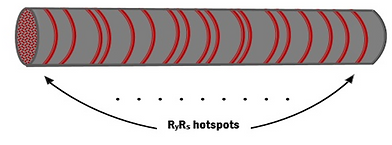Online first articles
Articles not assigned to any issue
.png)
ORIGINAL RESEARCH
Quantum Potential Geometry: a framework for ontophysical processes underlying
phenomenality
Roman R. Poznanski
Quantum Potential Geometry (QPG) is a process-based framework for modeling delocalized information systems in the brain. It is formulated within a Weyl-like geometric setting, where phase relations are encoded as scale connections, and the effective quantum potential (Q* ) specifies geometric curvature rather than probabilistic amplitudes. QPG conceptualizes neuropil microcavity–supported quasipolaritons as forming a discrete relational lattice, arising from diachronic boundary conditions, which constitutes the ontophysical substrate of the framework. When coherence extends across many microcavities through Q*, this discrete lattice undergoes a transition: its local relational structure generates a globally coherent phase configuration, whose effective curvature manifests as an emergent functional manifold at the macroscopic scale. QPG employs the Heisenberg formulation because quantum-delocalized informational dynamics arise not from nonlocal operators but from the intrinsic physical nature of quasipolaritonic modes, which cannot be simultaneously localized in complementary observables. Operators themselves are local mathematical objects; it is the Heisenberg uncertainty principle that imposes delocalization constraints on the modes. These constraints allow coherence to span microcavities, enabling long-range phase coupling and the formation of an extended functional geometry. Phase information is an ontophysical process, biophysically instantiated, it describes how local phase relations among domains are modulated to sustain coherence via a selection mechanism that restricts global phase patterns to those consistent with the Weyl-like scale connection and satisfying functional holonomy.
COMMENTARY
Upgrading the Turing Test for Consciousness
Luke Kenneth Casson Leighton
In Where is the Definition of Consciousness? (WdDoC), it was argued that the traditional Turing Test requires significant revision to address a broader and more inclusive definition of consciousness—one that applies not only to humans, but also to non-human animals, synthetic biological constructs such as xenobots, and potentially other emergent systems. Under this expanded framework, updating the Turing Test becomes largely redundant, particularly given its anthropocentric bias. Using a proposed definition of consciousness that closely parallels definitions of learning, this article asserts that the degree of consciousness expressed by any given entity may vary in sophistication or simplicity according to its architecture and resources. However, the core criteria used for assessment remain constant: (1) Advaita Vedanta-inspired Boolean-algebraic discrimination capability, (2) memory, (3) imagination/creativity, and (4) the ability to act upon predictive insights and learn from past errors. Under these criteria, even Proportional-Integral-Derivative (PID) control systems qualify as minimally conscious, highlighting both the difficulty and rigor required in establishing a meaningful test—comparable to the exhaustive certification standards used in safety-critical engineering. While it is acknowledged that evaluating only a single entity (or a very small sample) introduces statistical risk, this paper challenges the assumption that testing groups is the only viable mitigation approach. Group-level testing is subject to the same limitations in statistical generalisation unless sample sizes are sufficiently scaled. Ultimately, testing for consciousness in an individual is functionally equivalent to administering a sophisticated variant of the classic behavioural challenge: “Can you run and catch a moving ball?”

ORIGINAL RESEARCH
Intracellular Calcium Dynamics in Starburst Amacrine Cell Dendrites:
The Onset of Cardinal Direction Selectivity and Speed Tuning*
N.L. Iannella
Detecting moving objects is crucial in the animal kingdom and is fundamental to vision. In the vertebrate retina, starburst amacrine cells are directionally selective in terms of their calcium responses to stimuli that move centrifugally from the soma. The mechanism by which starburst amacrine cells show calcium bias for centrifugal motion is still to be determined. Recent morphological studies using fluorescent microscopy and immunostaining have shown that the endoplasmic reticulum is omnipresent in the soma, extending to the distal processes of starburst amacrine cells. Electron microscopy for ChAT SAC in adult rat retina unequivocally proves the presence of local endoplasmic reticulum. The submicron in diameter dendrites implies that the endoplasmic reticulum is not luminally connected between the soma and the distal tips. We construct a computational model of SAC dendrites with ER to simulate the Ca2+-induced Ca2+ release (CICR)-based calcium waves in the presence of unsaturated buffer to test the hypothesis that CICR mechanism can sustain constant calcium wave propagation in the centrifugal direction. The veto mechanism with a 100msec delay for the operation of retinal direction selectivity. is a working hypothesis, in which a CICR mechanism in the presence of local endoplasmic reticulum underlies speed tuning for directionality and propagation failure in the centripetal direction due to a build-up of calcium hyperexcitability in the distal regions of starburst amacrine cells. Modeling the heterogeneity of calcium endoplasmic reticulum in simulated starburst amacrine cells sheds light on a possible explanation for the cause ...


.png)